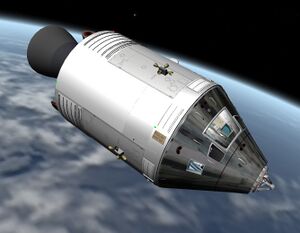Command/Service Module: Difference between revisions
imported>Tschachim |
imported>Tschachim No edit summary |
||
| Line 12: | Line 12: | ||
As the core of the Apollo hardware, the CSM is a high priority for Project Apollo - NASSP development. It has received a complete and ongoing overhaul for the 7.0 version, complete with new graphics, meshes and systems simulations. | As the core of the Apollo hardware, the CSM is a high priority for Project Apollo - NASSP development. It has received a complete and ongoing overhaul for the 7.0 version, complete with new graphics, meshes and systems simulations. | ||
=== Internal systems simulation === | |||
In order to make Project Apollo more realistic, some of it's mechanical, hydraulical and electrical devices, the "internal systems", are simulated. The internal systems affects the displays and controls of the panels and the behavior of the spacecrafts themselves. In terms of the real Apollo project these systems are mainly the EPS (Electrical Power System), ECS (Environmental Control System) and C&WS (Caution & Warning System). | |||
At the moment only a few system components are implemented. This is an ongoing development, so please check out this site occasionally for new features and improvements. | |||
The internal systems in Project Apollo are simulated with a slightly modified version of Radu Poenaru's [http://217.10.196.198/Orbiter/main.html System & Panel SDK (SPSDK)]. But only the "system" part of the PanelSDK is used, not the panel part. The panels are still managed by the Project Apollo toggleswitch library. | |||
The systems and components are described as they are modelled in Project Apollo with the SPSDK. It's no documentation of the real Apollo systems. Both systems are similar and should behave identical as much as possible, but there are some differences and simplifications, of course. | |||
Revision as of 18:05, 11 October 2006
Project Apollo simulates the Block II Command/Service Module (CSM), providing a home and life support for the astronauts in space. The CSM consisted of two parts, the Command Module (CM) and the Service Module (SM).
Structure & components

The Command Module (CM) was the nerve center of the Apollo spacecraft, as it functioned as primary control and navigation platform during the missions. It housed the highly-advanced (for the 1960s) Apollo Guidance Computer, as well as all the systems the astronauts would need to safely re-enter earth's atmosphere.
The Service Module (SM) contained the systems that were vital for the extended stay of up to 10 days in space. This included fuel cells to provide power and water, as well as radiators to keep the internal systems cool. Also housed in the service module were the primary propulsion systems, including the RCS maneuverability thrusters and the SPS, used for major course corrections. In later Apollo lunar missions, this versatile component contained a SIM Bay for additional scientific study of the lunar surface the space surrounding our nearest celestial neighbor.
Features
As the core of the Apollo hardware, the CSM is a high priority for Project Apollo - NASSP development. It has received a complete and ongoing overhaul for the 7.0 version, complete with new graphics, meshes and systems simulations.
Internal systems simulation
In order to make Project Apollo more realistic, some of it's mechanical, hydraulical and electrical devices, the "internal systems", are simulated. The internal systems affects the displays and controls of the panels and the behavior of the spacecrafts themselves. In terms of the real Apollo project these systems are mainly the EPS (Electrical Power System), ECS (Environmental Control System) and C&WS (Caution & Warning System).
At the moment only a few system components are implemented. This is an ongoing development, so please check out this site occasionally for new features and improvements.
The internal systems in Project Apollo are simulated with a slightly modified version of Radu Poenaru's System & Panel SDK (SPSDK). But only the "system" part of the PanelSDK is used, not the panel part. The panels are still managed by the Project Apollo toggleswitch library.
The systems and components are described as they are modelled in Project Apollo with the SPSDK. It's no documentation of the real Apollo systems. Both systems are similar and should behave identical as much as possible, but there are some differences and simplifications, of course.